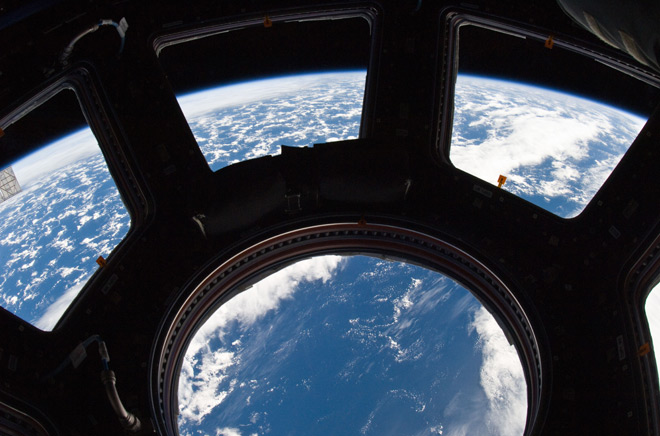It looks like you're using an Ad Blocker.
Please white-list or disable AboveTopSecret.com in your ad-blocking tool.
Thank you.
Some features of ATS will be disabled while you continue to use an ad-blocker.
share:
originally posted by: DrWily
a reply to: WaxingGibbons
I've seen no convincing arguments that would lead me to believe that those images are "impossible" or even composite.
In this interview with a cupola photographer, he talks about using wide angle lenses and there are a few pictures show that clearly show space around the Earth. In one picture you can see that if you got just a little closer to the window, bamn, there is your "impossible" shot.
www.diyphotography.net...
Is it a perfect 1:1 ratio image of the Earth? No. Does that mean it's fake? No.
While it is true that light travels in a straight line, it can be bent and manipulated by lenses... They pretty much had this technology in the bag as early in Victorian times, over 120+ years ago. So I find it paradoxical that in the age of atomic weapons, computers, rockets, and lasers... People can't comprehend that a centuries old technology can easily handle this kind of shot. I mean, seriously, this is the kind of thing you learn about in Elementary School.
drive.google.com...
Forgive the crudeness of the above drawing, but it's only there to illustrate the physics involved. As you can see from the drawing, light enters all 7 windows from different angles. Since the wide angle lens is like a big dome, light hits all parts of the dome and results in the images that WaxingGibbons originally posted. I'm not sure I can break it down any simpler than that. If someone can prove me wrong, please do.
You're right.
ETA - at the DIY Photography link, Don Pettit's photo, the third image down (if you include the video image) is also a perfect example of a photo that has been corrected for distortion - just for the information of anyone who would want to know.
edit on 3/25/2017 by TarzanBeta because: (no
reason given)
originally posted by: chrismir
a reply to: WaxingGibbons
Not fake, just a fisheye lens. In that picture the middle window and the surrounding windows look flat, while in reality they are side windows
That is what I see. The other windows are not flat but angled up, so the lens must be like 28 or so. Doesn't most pictures from NASA tell the lens camera etc too?
The gist is when we have that fisheye....just like the posts three and four before this.....the previous page, precisely....we use a pic with the
cupola frame included...you see where I go now.....
The fisheye may be taken out side and cgi'd under the paste and go image of the cupula
O P was about that, actually. In espanole...Fonzy would say.....Correctamundo
The fisheye may be taken out side and cgi'd under the paste and go image of the cupula
O P was about that, actually. In espanole...Fonzy would say.....Correctamundo
originally posted by: WaxingGibbons
a reply to: Zaphod58
It is clearly not the frame, this would make the windows twice as narrow as they obviously are.......
Like I said, straight denial of obvious and simple facts........
you seem to be forgetting that the earth is a sphere below the iss. thats why u can see the blackness of space around it. your not seeing all of the earth like u are assuming. just a small portion of the sphere.
I haven't bothered to read the whole thread yet (I'm still at page 3 or 4 a'd I am loving how it unfolds )
But, yup, this definitely looks like the result of a fish eye lens.
But, yup, this definitely looks like the result of a fish eye lens.
OP,
Fisheye lenses are amazing aren't they?
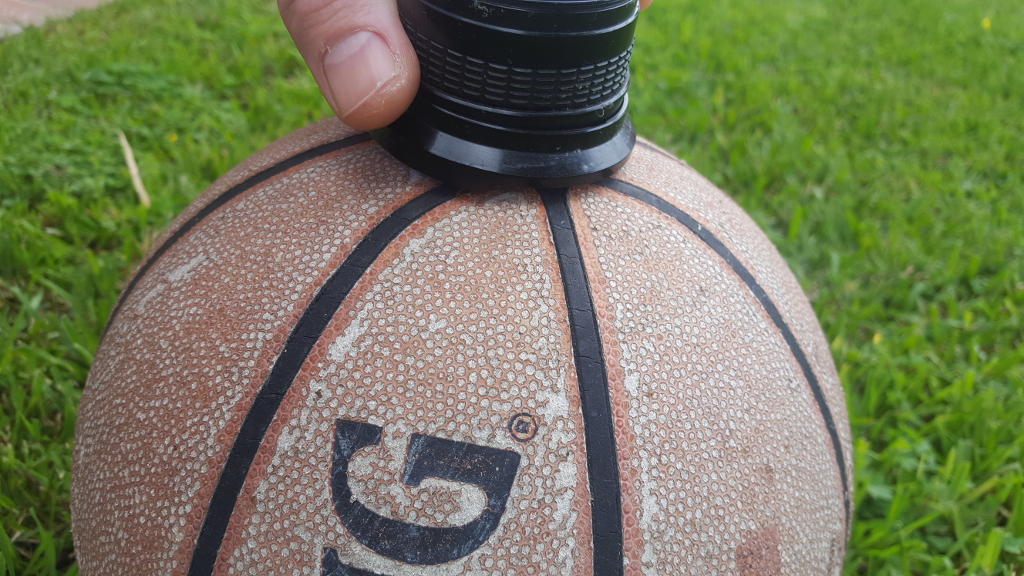
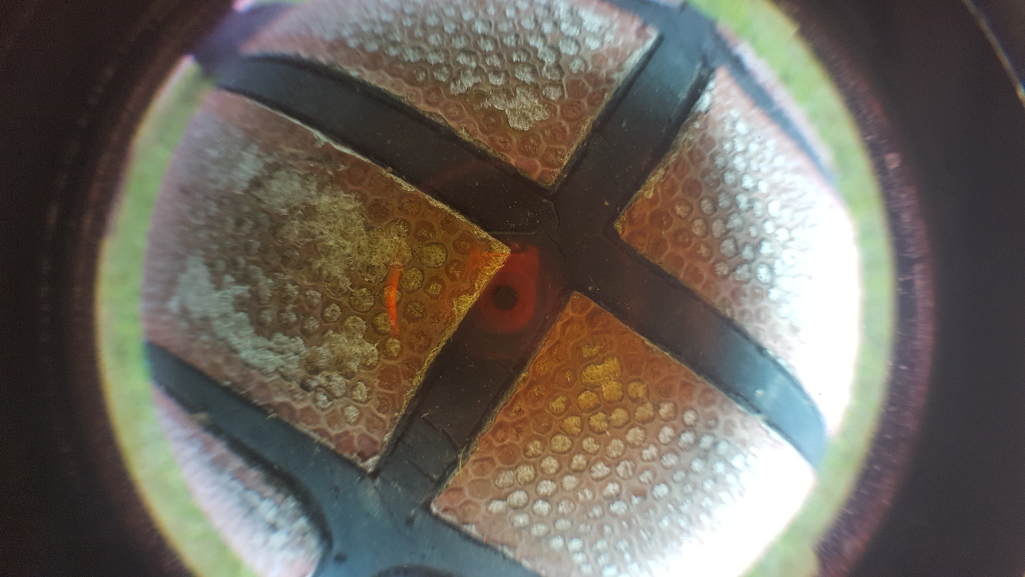
If this was just a normal lens, there is no way looking through it would show the edges of the basketball and the grass. However, this is a super wide fisheye lens and it can capture light from the edges just fine.
Same thing is happening in the ISS images. The little windows around the center circular window are capable of seeing the edge of the Earth (horizon). With a fisheye lense you can get them all in one shot and it will capture what appears to be the entire half of the Earth (but its not).
Lunar I.R. Series Super Wide Macro Lens 0.42x AF
Lens is held about 1/4 of an inch above the ball.
Used a camera phone to view through the lens, it is not attached to a camera.
Fisheye lenses are amazing aren't they?


If this was just a normal lens, there is no way looking through it would show the edges of the basketball and the grass. However, this is a super wide fisheye lens and it can capture light from the edges just fine.
Same thing is happening in the ISS images. The little windows around the center circular window are capable of seeing the edge of the Earth (horizon). With a fisheye lense you can get them all in one shot and it will capture what appears to be the entire half of the Earth (but its not).
Lunar I.R. Series Super Wide Macro Lens 0.42x AF
Lens is held about 1/4 of an inch above the ball.
Used a camera phone to view through the lens, it is not attached to a camera.
edit on 25-3-2017 by NAVSEA because: (no reason given)
originally posted by: WaxingGibbons
originally posted by: SaturnFX
originally posted by: chrismir
a reply to: WaxingGibbons
Not fake, just a fisheye lens. In that picture the middle window and the surrounding windows look flat, while in reality they are side windows
Fisheye lens would be my initial assumption, yes. not sure why ops didn't consider this the second he seen it.
I guess its more cooler to think we are living on some sort of dish that some gigantic deity keeps on his dresser in his mind.
Because you simply can't see more than about 4700 km of the surface from 450 km. That's why. No lense can look around corners, or an horizon, not even by one degree.
Well the answer was already given. my first assumption was fisheye because it would show a warped view with the space at the 180 degree lens of course.
So..long story short, professional photoshop to make it look super cool..and as a side bonus, weird out the flat earthers and such.
originally posted by: NAVSEA
OP,
Fisheye lenses are amazing aren't they?
If this was just a normal lens, there is no way looking through it would show the edges of the basketball and the grass. However, this is a super wide fisheye lens and it can capture light from the edges just fine.
Same thing is happening in the ISS images. The little windows around the center circular window are capable of seeing the edge of the Earth. With a fisheye lense you can get them all in one shot and it will capture the entire Earth. Mind you, there is a lot of Earth hidden behind the window frame between the circular center window and the little outside windows.
Lunar I.R. Series Super Wide Macro Lens 0.42x AF
Lens is held about 1/4 of an inch above the ball.
Used a camera phone to view through the lens, it is not attached to a camera.
WaxingGibbons, just keep looking at NAVSEA's post over and over until you understand the answer, ok?
It's ok. We'll wait.
edit on 25-3-2017 by MteWamp because: Stupid quote edit
(post by humanoidlord removed for a serious terms and conditions violation)
a reply to: DrWily
It is not touching, it's about +-1/4 inch away.
The thing to note here is that the fisheye can not see the North and South pole of the basketball. It can only see the horizon, 360 degrees of it. In one picture this makes you believe you see the entire half of the basketball, but you don't.
It is not touching, it's about +-1/4 inch away.
The thing to note here is that the fisheye can not see the North and South pole of the basketball. It can only see the horizon, 360 degrees of it. In one picture this makes you believe you see the entire half of the basketball, but you don't.
edit on 25-3-2017 by NAVSEA because: (no
reason given)
originally posted by: NAVSEA
a reply to: DrWily
It is not touching, it's about +-1/4 inch away.
The thing to note here is that the fisheye can not see the North and South pole of the basketball. It can only see the horizon, 360 degrees of it. In one picture this makes you believe you see the entire half of the basketball, but you don't.
Yeah, I was making that point earlier as well. Even if you extend the distance from the Earth to infinity, you can't see the full 50%. You can get closer to 50% as you approach infinity, but you'll never actually reach it.
edit on 25-3-2017 by DrWily because: Added a period. XD
OP,
Your graphic is correct. However, your idea that we are seeing the entire hemisphere of Earth is not correct. We are only seeing a very small portion of Earth and the horizon. Maybe this will help:
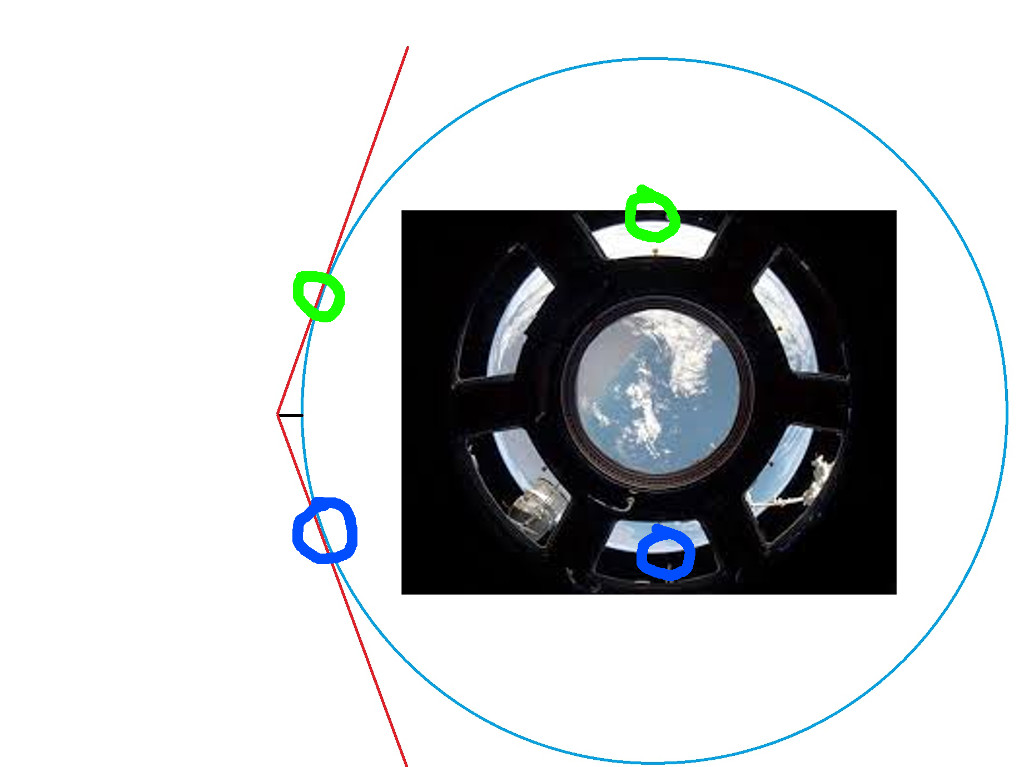
I have circled the parts of the graphic and the image in question to help you understand what you are seeing. As you can see in your graphic, we only see the part of Earth that is below the green circle and above the blue circle. Basically, the circles are on the horizon. We can see the edge of Earth and the dark space above it because its the horizon. The ISS photo is only a picture of the true horizon from their view point...
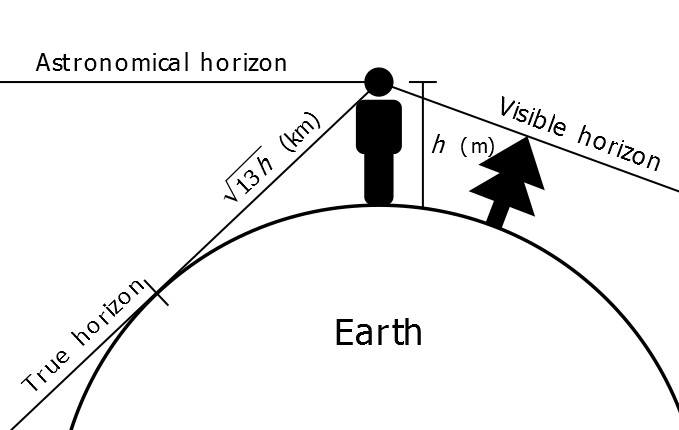
Your graphic is correct. However, your idea that we are seeing the entire hemisphere of Earth is not correct. We are only seeing a very small portion of Earth and the horizon. Maybe this will help:

I have circled the parts of the graphic and the image in question to help you understand what you are seeing. As you can see in your graphic, we only see the part of Earth that is below the green circle and above the blue circle. Basically, the circles are on the horizon. We can see the edge of Earth and the dark space above it because its the horizon. The ISS photo is only a picture of the true horizon from their view point...

edit on 25-3-2017 by NAVSEA because: (no reason given)
Hey, OP, a lot of people are taking time out of their lives to show you. That's a sign of respect- not a sign of demeaning. Take it for what it is,
friend.
originally posted by: MteWamp
originally posted by: NAVSEA
OP,
Fisheye lenses are amazing aren't they?
If this was just a normal lens, there is no way looking through it would show the edges of the basketball and the grass. However, this is a super wide fisheye lens and it can capture light from the edges just fine.
Same thing is happening in the ISS images. The little windows around the center circular window are capable of seeing the edge of the Earth. With a fisheye lense you can get them all in one shot and it will capture the entire Earth. Mind you, there is a lot of Earth hidden behind the window frame between the circular center window and the little outside windows.
Lunar I.R. Series Super Wide Macro Lens 0.42x AF
Lens is held about 1/4 of an inch above the ball.
Used a camera phone to view through the lens, it is not attached to a camera.
WaxingGibbons, just keep looking at NAVSEA's post over and over until you understand the answer, ok?
It's ok. We'll wait.
Ahaha, is the lense of the camera on board the ISS 1000's of km's wide........
Here, I 3D modeled it for you...
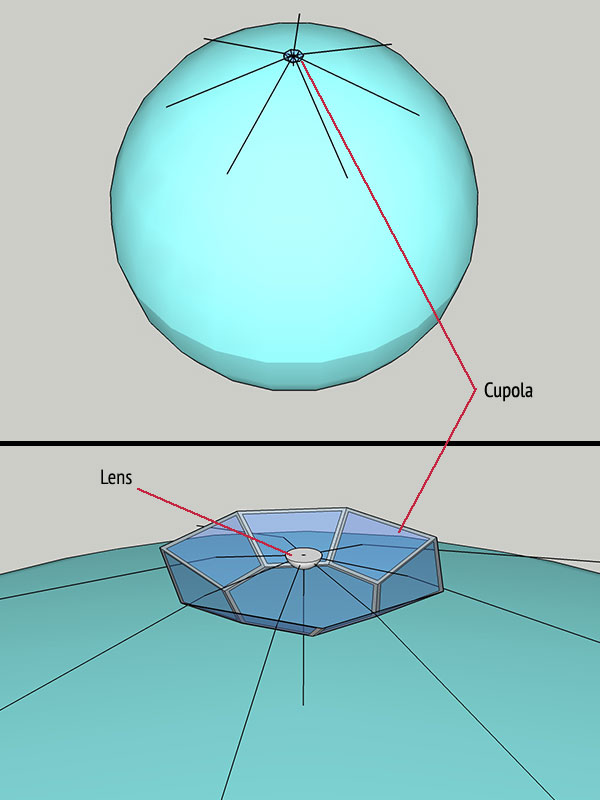
As you can see, the fish-eye lens is a dome situated within the "dome" of the cupola.
The lines represent the viewing angle of a tangent from the earth perpendicular to the surface of the "curved lens", through the 7 windows of the cupola. The lines are bent slightly to show the refraction through he windows.
Obviously not to scale, but shows the concept that everyone has been trying to describe to you throughout this thread.
Hopefully this helps you understand how the image was produced from a single photograph.

As you can see, the fish-eye lens is a dome situated within the "dome" of the cupola.
The lines represent the viewing angle of a tangent from the earth perpendicular to the surface of the "curved lens", through the 7 windows of the cupola. The lines are bent slightly to show the refraction through he windows.
Obviously not to scale, but shows the concept that everyone has been trying to describe to you throughout this thread.
Hopefully this helps you understand how the image was produced from a single photograph.
a reply to: puzzlesphere
I don't need help, we already established that some of these pics show a portion of the Earth, why does it look like sphere with space around it?
Myeah, no. Those points you circled are 3-4000 km apart.
The surface we see in this pic for instance is only about 700km across.

Your graphic is correct. However, your idea that we are seeing the entire hemisphere of Earth is not correct. We are only seeing a very small portion of Earth and the horizon. Maybe this will help:
I don't need help, we already established that some of these pics show a portion of the Earth, why does it look like sphere with space around it?
I have circled the parts of the graphic and the image in question to help you understand what you are seeing. As you can see in your graphic, we only see the part of Earth that is below the green circle and above the blue circle. Basically, the circles are on the horizon. We can see the edge of Earth and the dark space above it because its the horizon. The ISS photo is only a picture of the true horizon from their view point...
Myeah, no. Those points you circled are 3-4000 km apart.
The surface we see in this pic for instance is only about 700km across.

a reply to: puzzlesphere
Ooh shiny.....
Not sure what your point is. In any case, in the pics I posted in my op, the camera is not pressed against the glass, it's like 2 m backed up.......
Ooh shiny.....
Not sure what your point is. In any case, in the pics I posted in my op, the camera is not pressed against the glass, it's like 2 m backed up.......
new topics
-
What is the white pill?
Philosophy and Metaphysics: 1 hours ago -
Mike Pinder The Moody Blues R.I.P.
Music: 1 hours ago -
Putin, Russia and the Great Architects of the Universe
ATS Skunk Works: 4 hours ago -
A Warning to America: 25 Ways the US is Being Destroyed
New World Order: 9 hours ago
top topics
-
President BIDEN's FBI Raided Donald Trump's Florida Home for OBAMA-NORTH KOREA Documents.
Political Conspiracies: 15 hours ago, 33 flags -
A Warning to America: 25 Ways the US is Being Destroyed
New World Order: 9 hours ago, 18 flags -
Is AI Better Than the Hollywood Elite?
Movies: 16 hours ago, 4 flags -
Mike Pinder The Moody Blues R.I.P.
Music: 1 hours ago, 4 flags -
What is the white pill?
Philosophy and Metaphysics: 1 hours ago, 4 flags -
Putin, Russia and the Great Architects of the Universe
ATS Skunk Works: 4 hours ago, 2 flags -
Maestro Benedetto
Literature: 16 hours ago, 1 flags
active topics
-
Gaza Terrorists Attack US Humanitarian Pier During Construction
Middle East Issues • 67 • : FlyersFan -
What is the white pill?
Philosophy and Metaphysics • 4 • : BrotherKinsMan -
Truth Social goes public, be careful not to lose your money
Mainstream News • 134 • : lilzazz -
Starburst galaxy M82 - Webb Vs Hubble
Space Exploration • 6 • : Arbitrageur -
One Flame Throwing Robot Dog for Christmas Please!
Weaponry • 11 • : Therealbeverage -
Ditching physical money
History • 21 • : SprocketUK -
Graham Hancock being proven right all along about ancient humans in America.
Ancient & Lost Civilizations • 106 • : JonnyC555 -
President BIDEN's FBI Raided Donald Trump's Florida Home for OBAMA-NORTH KOREA Documents.
Political Conspiracies • 29 • : MetalThunder -
Putin, Russia and the Great Architects of the Universe
ATS Skunk Works • 17 • : BrotherKinsMan -
Massachusetts Drag Queen Leads Young Kids in Free Palestine Chant
Social Issues and Civil Unrest • 18 • : ToneD

